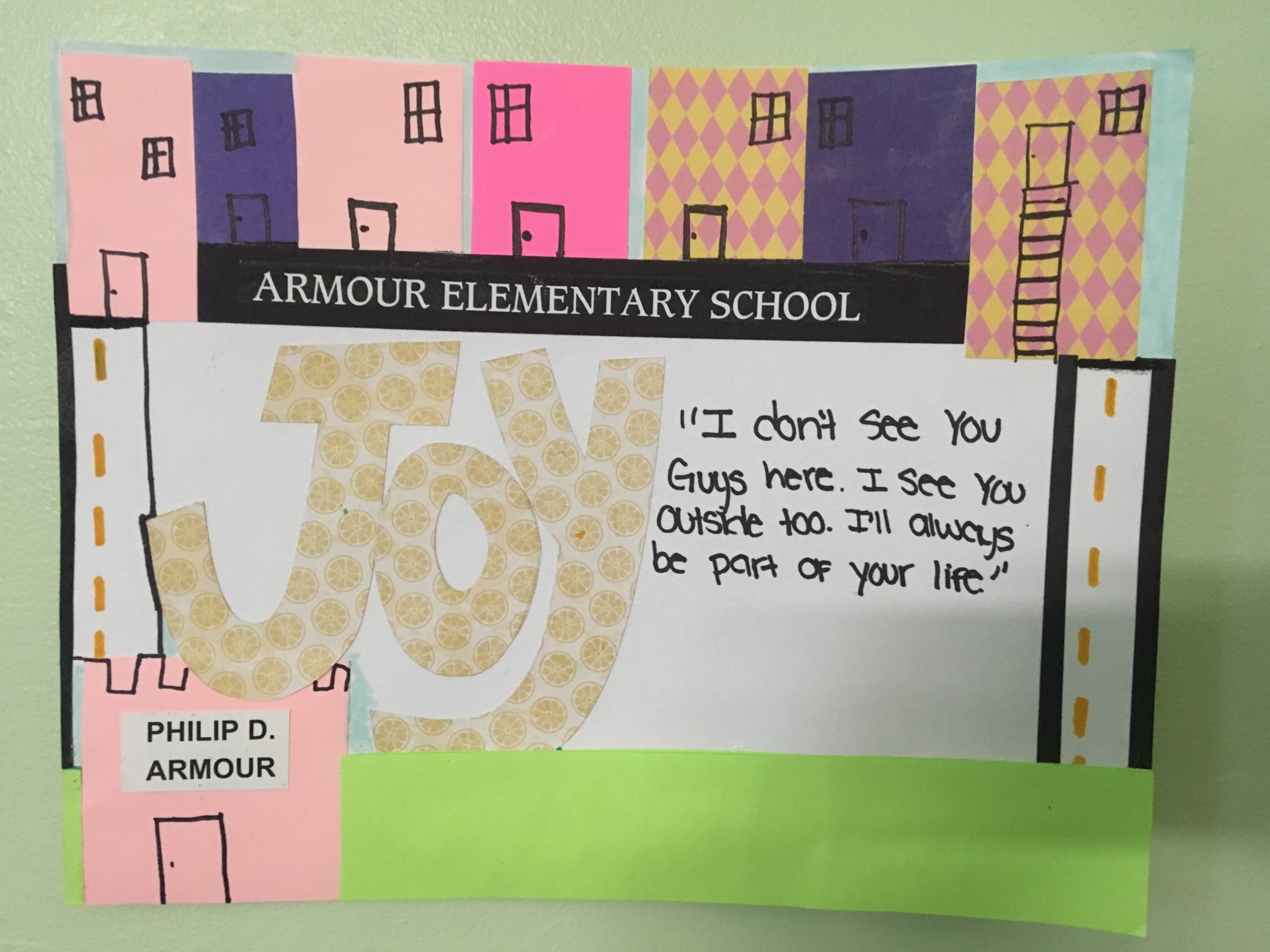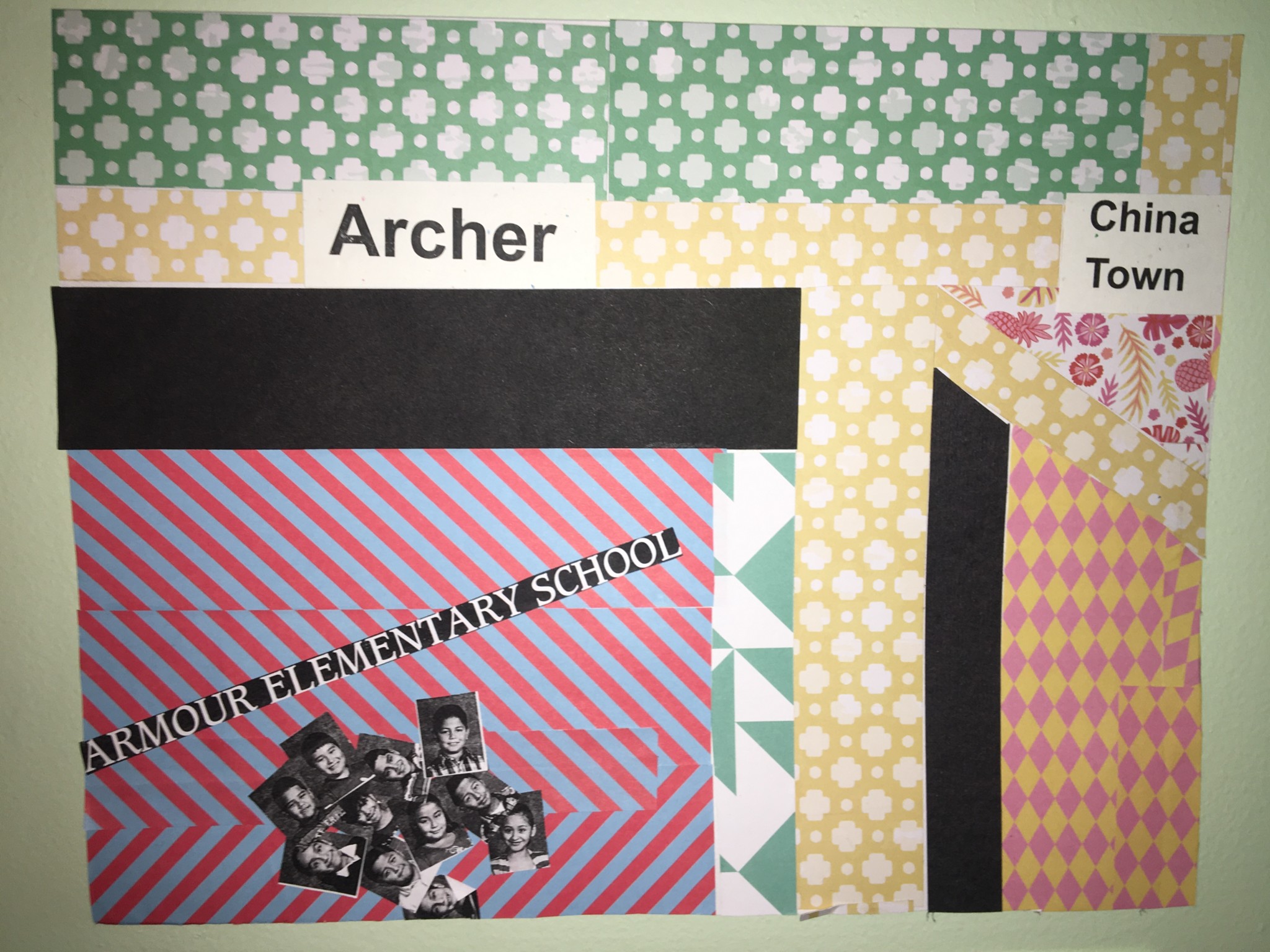On Wednesday, June 13, the 8th grade class from Philip D. Armour Elementary gathered in the backroom of Bridgeport Coffee, five blocks north on Morgan Street from their school building, to celebrate the maps they had created of Bridgeport. For eight weeks, in collaboration with the Jane Addams Hull-House Museum at the University of Illinois at Chicago, the students had perused archival collections of Bridgeport and other neighborhoods and learned about the ways in which maps represent communities. “Mapping the Neighborhood,” the name of their exhibition, featured maps of varying scale, focus, and artistic style in an attempt to answer a question: how is Bridgeport changing?
Students answered this question by focusing on the places that were important to them. One student showed the places she stops by on her way home from school, including the park of a neighboring school where she plays basketball with friends. Another student wrote “CLOSED” in the center of her map and placed names of vacant former neighborhood establishments around it, like Halsted Foods, Rexall Union Drugs, and the Ramova Theater.
The maps were partly drawn, but also contained glued-on shapes, signs, and pictures of classmates. A few students included a quote from one of the Armour teachers, Mr. Franco: “I don’t just see you here, I see you outside, I’ll always be a part of your life.”
Montse Saucedo, one of the 8th graders who included the quote in her map, explained that Mr. Franco had been talking about seeing students outside of school in addition to inside the school, driving home that they were part of a community broader than the school. In her map, Montse pasted the word “Joy” in large letters and said she wanted people to see that “everybody [in Bridgeport] gets along.”
Another student, Jie Wang, wanted to show the divide between Bridgeport and neighboring Chinatown. His map focused on the area around the intersection of South Archer Avenue and South Halsted Street, where several bridges and highways form physical barriers that tack onto whatever cultural divides exist between the neighborhoods.
Around thirty people attended the exhibition, including students, teachers, and Hull-House Museum staff. A few minutes before the exhibition kicked off, state Representative Theresa Mah explained the political relevance of mapping. In 2011, when she was a consultant with the Coalition for a Better Chinese American Community she worked on recommending to the Illinois House how to redistrict the Chinatown area, which, at the time, was split into several districts, dividing the power of the Chinese vote. Mah said that detailed maps and census statistics had been crucial to determining how to redistrict fairly; shortly thereafter, the change led to her election as the state’s first Asian-American legislator.
“Mapping the Neighborhood” originated in a different kind of question posed by the Hull-House Museum. The museum, which is housed in two of the original Hull-House buildings, “preserves and develops the original Hull-House site for the interpretation and continuation of the historic settlement house vision,” according to its website. The museum’s “exhibitions and public programs examine the histories of progressive education, democratic participation and social change.”
Michael Ramirez, in his seventh year at the Hull-House and its current education manager, said that the previous education manager began the idea for the project by asking: what could a partnership look like? Hull-House sent out a proposal for a collaborative project through Communities in Schools, a nonprofit that provides support for public school students.
Armour reached out to Hull-House soon after hearing about the proposal. Farrah Blake, who teaches art at Armour and guided students through the project, said the proposal was in line with the teaching philosophy of Armour, which is “thinking about what voice [the students] can express.”

In the first of eight weeks of collaboration, students toured the Hull-House and looked through its archival collection of photographs, newspaper clippings, and everyday objects. The collections date back to at least the 1930s and include objects left behind when many of the Hull-House buildings were demolished in the 1960s to make way for UIC to build its campus, as well as items from the Maxwell Street Market before it was moved in 1994 to make way for a UIC campus extension.
Kara Jefts, the Hull-House collections assistant, said the archival collections contained many everyday objects that were unremarkable at the time but “tell us a lot about the community that was there.”
For the next four weeks, Ramirez and other Hull-House educators visited Armour and worked with students on examining Armour archives of Bridgeport and of people that used to go to Armour. Many of the students had family members going back a generation that attended Armour. Educators also organized a panel discussion day with Armour alums and teachers who live or lived in the neighborhood talking about how they see Bridgeport changing.
The sense of being rooted to the place played a big role throughout the project and in students’ final works. While introducing the exhibition to attendees, Blake said that seeing how so many of her students could trace their roots through the school made her wish she grew up in Bridgeport too. Later, Blake explained that “where [the students] are rooted—that’s when they felt a connection. The beauty of making art is being connected to the piece.”
In the last three weeks, students worked on their maps. Josue Soto, whose map featured the 31st and Halsted strip mall near Armour with a CVS, GameStop, and Subway, among other stores where he likes to hang out with his friends, said that the project was “a bit boring” at first, but that it soon became fun for everybody. Montse also emphasized that the students had fun and got along with each other.
Both Armour and Hull-House were happy with how the collaboration turned out and plan on continuing and expanding the program in the future. Ramirez said Hull-House treated the collaboration as a pilot.
Blake, meanwhile, already had ideas for how to take the project a step further. But when asked what they were, she said we’ll have to wait and see.
The Hull-House Museum has several ongoing exhibitions as part of its multi-year program “Making the West Side,” including “Claiming Space: Creative Grounds and Freedom Summer School,” which explores public school spaces in the wake of school closures. Jane Addams Hull-House Museum, 800 S. Halsted St. Open through July 29.
Adam Przybyl is the Weekly’s deputy editor. He last wrote for the Weekly in May about Democratic nominee for Cook County Assessor Fritz Kaegi’s plans for office and the feasibility of his reform program.


